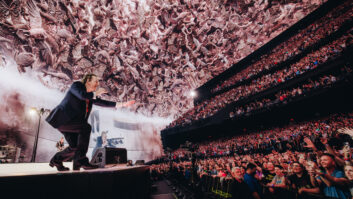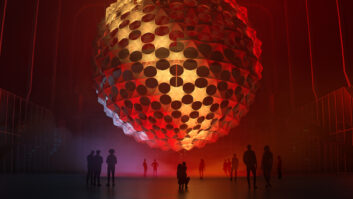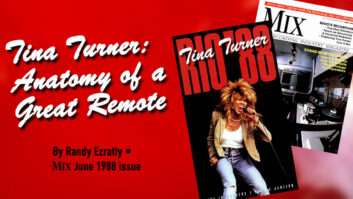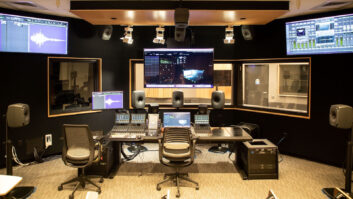A few years ago, the chief engineer at one of the busiest audio post houses in Boston, a multiroom facility that does mostly TV commercials and hosts some of the top agencies and accounts in the country, outfitted all of his rooms with superb 5.1 surround monitoring systems. Every year, I bring a group of students around for a “real-world” visit to his shop, and every year, I ask the same question: “How often do they actually mix spots in 5.1?” And every year, he gives me the same answer: “Almost never.” As he explains it, “In the middle of the Super Bowl, when the president of Toyota calls up his ad agency and asks them why the heck his ads are in stereo while the game is in surround — that’s when we’ll start working in 5.1.” So far, it hasn’t happened.
So does this mean nobody is watching the Super Bowl in surround sound? Not at all; the explanation is a bit more complicated. But it has got me thinking about the pitfalls of doing surround broadcasting for live events on television.
Recently, I had lunch with Phil Adler, an old friend who for the past 18 years has been mixing sports for TV. Phil, whom I met many years ago when he engineered one of the first albums I produced, has worked for NBC, Fox, HBO and the NBA, but these days, his main client is CBS. Our conversation got me even more curious about the subject. So I talked to some more people and I found out a lot about how surround mixes for sports are created, how they’re distributed, how they’re transmitted and what can go wrong along the way, which is quite a bit.
There’s an oft-cited theory that the driving force behind any new technology during the past 20 years has been pornography. It certainly could be argued that this was true for early video discs, VCRs, camcorders, DVDs and the World Wide Web. But surround audio isn’t in that category. Its driving forces are DVD movies, videogames and live sports. In some ways, sports are the most interesting because there’s only one delivery medium — television — and whatever anyone wants to do anywhere along the line, it has to get funneled through that channel.
According to Jim Hilson, senior broadcast audio specialist at Dolby Labs (and also a former recording engineer), “The real issue is that DVD movies and videogames are coming out in 5.1. If TV is just in stereo, people notice the difference. People equate 5.1 with HD, but there are a lot of people still listening in stereo even though what they’re receiving is 5.1. There are way more DVD players than there are Dolby Digital decoders. But a lot of people have home theater systems and they’re beginning to hook up their digital TVs to them.”
Now I do have to admit that I do not watch sports on TV very often. Oh, I’ll sometimes have a baseball game going while I’m doing something else, particularly in those not-as-rare-as-they-used-to-be interludes when the Red Sox are doing well, but generally speaking, watching a screenful of guys in colorful, if sometimes dirty, costumes who make more in a week than I do in 10 years, running around chasing balls or pucks, or riding on top of large quadrupeds or ridiculously overpowered internal-combustion engines doesn’t do much for me. And I should also admit that I don’t have a surround system hooked up to my TV. So I’m not approaching this as a fan.
That said, I have a great deal of admiration for what sports mixers do, especially these days when they’re expected to create a soundtrack as complicated and compelling as a Hollywood movie score on the fly. What they have to deal with — wireless and crowd mics, instant and not-so-instant replays and sound effects under swooping graphics, not to mention the director and sometimes the network yelling in their ear — is pretty amazing. Phil once came into a class of mine and played a tape with the mono game mix on one channel and the production intercom on the other. I was impressed, and the students were horrified.
As we move into the age of high-definition (HD) television, surround sound in broadcast is becoming more the rule than the exception. Unlike standard-definition (SD) broadcasts, multichannel audio hasn’t been jury-rigged onto the medium but is instead an integral part of it. But it’s still going to be awhile before it becomes the rule among audience members. Hard figures are difficult to come by, but it’s probably safe to say that fewer than one-sixth of TV viewers at home are currently watching in HD, and according to my friend Phil, when it comes to sports, “There’s still more stuff going out not HD than is HD.” And it’s also going to be awhile before all the kinks are worked out of the surround sound signal chain, and before everyone agrees on how best to handle it.
At a typical sports event, according to Phil, the mixing engineer might have 60 or more audio sources to wrangle. They include tape (or in the case of many new trucks, tapeless) feeds for replays, highlight reels and produced packages, but the most important ones are the microphones. “Sports coverage requires a lot of mics,” Phil says, “around the playing area, in the playing area and on the players themselves, when it’s allowed.” In a typical truck’s arsenal are shotguns, lavaliers, boundary mics, headsets for the announcers and theatrical mics on the commentators’ studio set. There are mics in the locker rooms and on every roving video camera. Some mixers like more than others: A typical basketball game will have 10 mics on the court, but Phil has seen at least one game with 30.
Umpires and officials wear wireless packs, and there are often four or more parabolic wireless mics around the arena. “Having RF mics means people can move untethered, but whenever possible, there is a hardwired backup for each wireless,” Phil says. “We try to coordinate frequencies with whatever town we’re in, but as the spectrum becomes more polluted, it’s more difficult. Someone can come in with a system who doesn’t coordinate with us and it knocks us right off the air. My field submixer is responsible for the wireless mics, and he has to move frequencies around all the time.”
Generally, it’s the crowd noise that makes up the bulk of what goes into the surround channels. “For NFL games, I would use five pairs of crowd mics at the 20-yard lines and the 50,” says Phil. “Two of the mics are on the cameras that work the sidelines, so they’re constantly moving, which makes for a nice, large sound field.” Surround mics including SoundField and Holophone models are finding their way into many sports mixes, such as the recent World Cup, which was broadcast for the first time from start to finish in HD, and which included a number of SoundField mics among the 18 that were covering the field.
Ron Scalise, the audio project manager for remote operations at ESPN (who also started his career as a music mixer), is one of the pioneers of surround sound for sports, starting with the cable network in the late 1990s, even before the delivery systems were all in place. When it comes to the surround mix, he says, “We’re not really interested in re-creating the arena we’re in. Overall, if you just present what’s there, it’s boring. We want to make it bigger than life. It’s all about the ‘wow’ factor. Like the video, when you’ve got a 100:1 lens on a camera, you can’t look into the quarterback’s eyes when you’re physically at the game, but you can on TV. In car racing, when you’re shooting with the inside camera, we make it like you’re in the car and get rid of the outside sound. We’re looking to make entertainment; make it exciting. We give people who have just gone out and spent 10 grand on their home theater systems something that will make them say, ‘Listen to that!’
“Even the prerecorded sound design for graphic panels and switcher wipes are mixed so they have movement from front to rear, as well as from left to right. But we don’t want to overdo it — to make them so loud that they will annoy people.
“Clever imaging can be extremely effective,” Scalise continues. “The more you can do besides just put the average sounds of the game in the front stereo stage, the better. You can always imply more of what there really is. Enhancing crowd sound and ambiences in the rear channels is important, as well. Establishing a general ‘seat in the stadium or arena’ environment is important, but from a perspective standpoint, if you have ever tried to follow every camera cut with the mics placed too closely, the sound changing each time the camera angle changed, you’d drive people crazy and they’d turn down the sound.
“At an X-Games ski event, there are people cheering at the bottom of the hill and shaking cowbells, so we’ll put them into the rear channels and keep them there. At college football and basketball games, we’ll take the team band, mike them in stereo and put them in the rear. We’ll put a mic on the peanut vendor and put him in the rear, leaning him left and right. And there are always those nuts at the games who paint ‘E S P N’ on their chests and take their shirts off in the middle of the game when they see the camera, even when it’s 10 degrees and snowing. We spot where they are before the game starts because we know that they’re going to be making noise and cheering loudly, so we put a mic near them and open it in anticipation of, say, a field-goal attempt. If it’s the opposing team’s ball, we place them in the rear. Hopefully, they’re not going to cuss; sometimes we put a delay on them just in case.”
On the other hand, says Phil, “We’re not trying to create something that doesn’t exist, like a film. We’re trying to capture an event and bring it home as best we can for the viewer. As far as processing goes, there’s no artificial ambience; it sounds weird when you do that. We use compression more than anything else, along with some EQ.”
Besides the complexity of the mix, one of the things sports mixers have to deal with is that they’re in a constantly changing work environment. “A few broadcast [series] get to keep the same truck all season, but most of us aren’t so lucky,” Phil says. “We don’t choose our truck, our environment, but we have to make it work, usually in a very short time. On average, you get a day and a quarter to set up: You get to the site and the next day is game day. There are a lot of trucks — maybe 25 or 30 HD trucks are out there now — and they’re building more of them all the time. They’re very expensive, but it’s not cost-effective to build a new truck that’s not HD-compatible. Generally, they’re built for specific contracts, usually five-year deals with a particular network for a particular sport.
“They’re getting better,” he adds, “but for the most part, very little thought has gone into the acoustical space or treatment when they’re building the truck. And it’s noisy; there’s air conditioning and computers all making noise. I remember in one truck there was a big computer controlling the intercom system right behind my left ear, and I said, ‘Get that out of there; it doesn’t need to be here.’
“The only trucks I’ve seen with treatment are music-specific. Almost everyone’s using Genelec monitors, so there’s consistency there, and audio consoles are getting more consistent: Calrecs are becoming very popular, but you also see SSL, Euphonix, Yamaha PM-1D and Midas if they’re using an analog signal chain. But the layout, the meter bridging, they’re all different. So like in any new studio, you put up some music you’re familiar with and listen to it.”
Unlike mixers for records or film, sports mixers don’t have the luxury of doing separate stereo and surround mixes at different times; everything is live. “Some mixers do a totally separate stereo mix off the desk,” says Phil, “or they’ll take it off the Dolby 563 encoder, which folds the signal into the Pro Logic II format, which can be listened to in either surround or stereo. And some will use a Dolby 570 monitoring tool to check the stereo feed. But since the balances are the same, you’re not really doing two separate mixes for HD and SD. For the stereo mix, I’ll just use left-front, right-front and center, and not even bother to put the surround channels into it.”
Another daunting problem that most music mixers don’t have to deal with is, as Phil says, “You can’t just concentrate on the production mix. You also have to listen to the director and the producer. There’s constant chatter. So I have another pair of speakers off to the side and in front of me for that, just so they don’t overpower the mix. Some people like those speakers behind them, but I find it irritating to be constantly pulling yourself forward and back.
“At the same time, I’m the only one paying attention to the mix. The video production people aren’t — that’s what they hire me for. We don’t even give them the mix since a lot can go wrong if we did; someone might be standing in front of one of the speakers or someone sitting in front of the right speaker can’t hear the announcer coming out of the center speaker, so they turn down the right channel. So I feed them mono, the lowest common denominator. After all, what they really want to hear is the announcer. And if something goes wrong with the phase, they will definitely hear that.”
Next month, we’ll talk about what happens when the mix leaves the truck — for better and for worse.
At the moment, Paul Lehrman is listening to the sound of the Atlantic Ocean in full surround.







